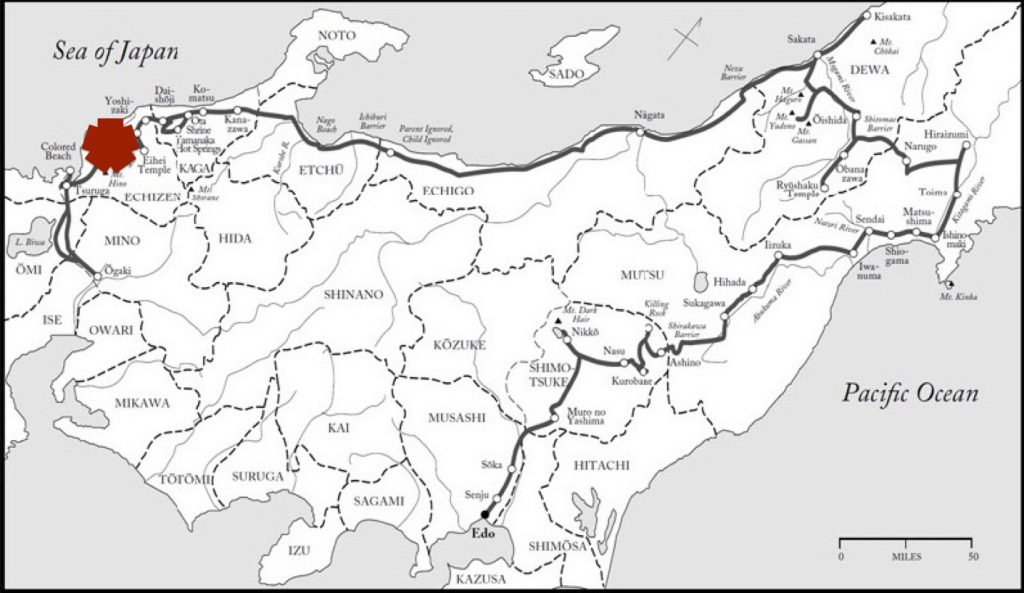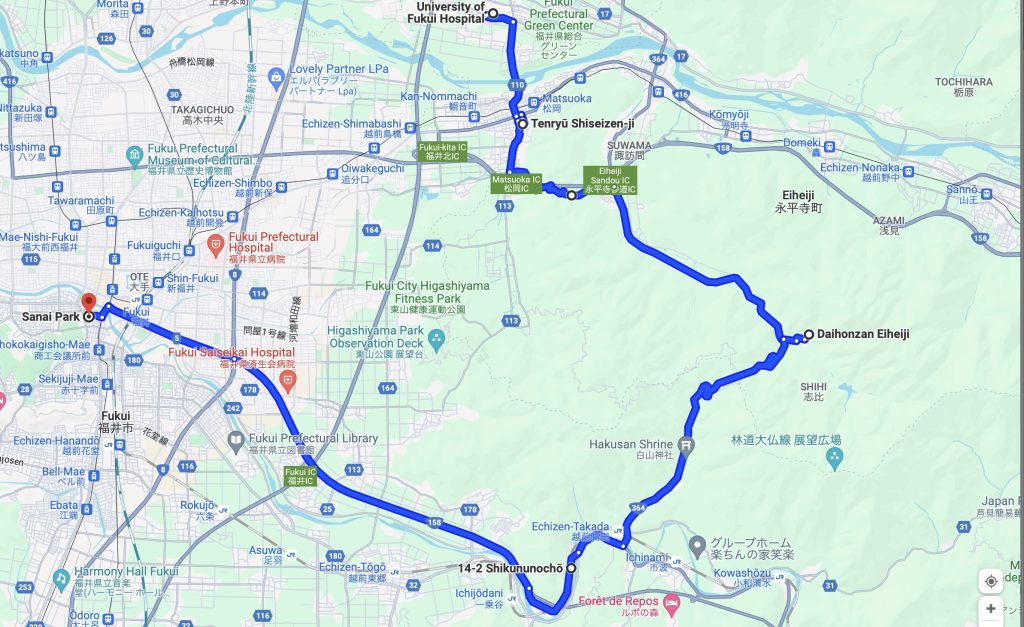Summary
An explanation of our goals in Japan.
So, while the students introduce themselves, let me describe why we are here. Our ultimate goal is to use a Matterport Pro3D, a LiDAR scanner, to capture immersive 3D scans of our test area, and then attach them to our proof-of-concept space in Unity. Seems simple enough, right? Well, this has been a long and interesting process to get to this point, with a long but relatively gentle learning curve.
For various reasons, for the Japan 2024 trip, we chose to focus on Bashō’s time in Fukui Prefecture, Japan.:
- Initially, we were supposed to do work in Yamagata Prefecture, but there was too much snow to do meaningful work when we could travel in March 2024.
- We were then supposed to focus on Kanazawa, but the December 31, 2023 earthquake made that unadvisable.
- Then, we were supposed to focus on Tsuruga, but our stay there corresponded with the opening of an important branch of the Hokuriku Shinkansen (fast train), so the town was filled with trainspotters and, you know, what a boozy mess that would have been.
- So we settled on Fukui, and that’s been a good choice.
Bashō stayed in Fukui for several days [see the excerpt below from The Narrow Road to the Deep North, concerning roughly 22 August – 4 September 1689). Bashō was traveling without his disciple Sora (1649-1710), who had fallen ill. Bashō had spent at least several days prior at Yamanaka Hot Springs, recovering from his voyage, and he visited and stayed at several temples (as he was an ordained priest, a role that gave him a lot of freedom to travel in addition to the fact that he was a literary rock star).

Our focus is on a 31 kilometer section of Bashō’s route here. Wera Kyaw Kyaw, Alec Sanders, Gideon Daniels, Ari Gutstein, Bryce Babcock, and many others have worked hard to build an immersive space in Unity to recreate the modern space through which Bashō walked, and into which we could insert content nodes for learning opportunities.

The first effort recreates the road leading to Daihonzen Eiheiji Buddhist Temple using pre-formed assets. Looks great, but would have required a lot of editing of these digital recreations:
The second effort does a better job of representing the actual space, but the superimposition of photographs of the buildings would also require a lot of work:

Furthermore, our conversations with various video game companies indicated that we needed a better look, feel, and functionality if we wanted to attract any attention.
So, we will capture Matterport scans of the street and the lead-up to the temple (we don’t have permission yet to scan within the temple), chain them together, and then finally have a working visual immersive space. Wera Kyaw Kyaw, Alec Sanders, and Bryce Babcock (and who knows who else is helping…) have a plan to immediately transfer the images back to Wera for placement in our Unity framework.
This represents a lot of hard work by my students, and they are to be congratulated for their efforts. Now, let’s let them do a little bit of tourism in Tokyo as they shake off jetlag, and I go off to do some Bashō related work.
Tomorrow we head to Fukui!
***
<汐越の松>
越前の境、吉崎の入江を舟に棹して汐越の松を尋ぬ。終宵嵐に波をはこばせて
月をたれたる汐越の松西行
一首にて数景尽たり。もし一辧を加るものは、無用の指を立る
がごとし。丸岡天竜寺の長老古き因あれば尋ぬ。又金沢の北枝といふもの、
かりそめに見送りて、此處までしたひ来る。所々の風景過さず思
ひつゞけて、折節あはれなる作意など聞ゆ。今既別に望みて、
物書て扇引さく余波哉十丁山に入て永平寺を礼す。道元禅師の御寺也。邦機千里を避
て、かゝる山陰に跡をのこし給ふも貴きゆへ有とかや。
I crossed Lake Yoshizaki by boat, the border of Echizen province, and went to visit the
Shiogoshi [Tide-Crossing] Pines.
throughout the long night
the waves are lashed by a storm
that drives them to shore –
and moonlight drips from their boughs,
the pines of Shiogoshi
In this single poem, Saigyō [1118 – 1190] crystallises the essence of the scene at Shiozaki. To add even a single word would be like adding an extra useless finger to a hand.
At Maruoka, I called upon an old friend, the abbot of the Tenryū Temple. A man called Hokushi, from Kanazawa, had intended to accompany me for a short distance, but he had finally come all the way to Maruoka, unable to say goodbye. No sight on the journey had escaped his notice, and he wrote some moving poems. Now that we were parting, I wrote:
I’ve scribbled words, but
how to tear the fan apart –
goodbyes are so hard*
I went three or four miles into the mountains to worship at Eiheiji, the temple of the Zen Master Dōgen. I understand that he had some profound reason for avoiding the vicinity of the capital and for building his temple in such remote mountains as these.
[*how to tear the fan apart now that summer had ended, a fan was no longer needed. In spite of this, Bashō seems to have impulsively scribbled some words on a fan, which made it all the more difficult to throw it away.]
<福井>
福井は三里計なれば、夕飯したゝめて出るに、たそがれの路たど/\し。爰に等栽と云
古き隠士有。いづれの年にか江戸に来りて予を尋。遥十とせ餘り也。いかに老さらぼひ
て有にや、将死けるにやと人に尋侍れば、いまだ存命してそこ/\と教ゆ。市中ひそ
かに引入て、あやしの小家に夕顔へちまのはえかゝりて、鶏頭は木ゝに戸ぼそをかくす
。さては此うちにこそと門を扣ば、侘しげなる女の出て、いづくよりわたり給ふ道心の
御坊にや。あるじは此あたり何がしと云ものゝ方に行ぬ。もし用あらば尋給へとい
ふ。かれが妻なるべしとしらる。むかし物がたりにこそかゝる風情は侍れと、やがて尋
あひて、その家に二夜とまりて、名月はつるがのみなとにとたび立。等栽も共に送らん
と裾おかしうからげて、路の枝折とうかれ立。
Although Fukui was only six or seven miles away, I did not set out until after supper, and it was an uncertain journey along the twilit road. Fukui was where Tōsai had long been living as a recluse. He had come to Edo and visited me once – I was not sure exactly when, but it must have been more than ten years previously. I assumed he must be very old and feeble now, perhaps even dead. But when I asked about him, I was told that he was still alive in such-and-such a place. I found his wretched, tiny house in an out-of-the-way corner of the town. Moonflowers and bottle-gourds covered the walls, and the door was hidden beneath cockscomb and broom grass. This must be it, I thought, and rapped on the gate. A woman of humble appearance came out and asked: ‘Where have you come from, your reverence? The master’s gone to visit someone in the neighborhood. If you’ve got business with him, please search him out there.’ I assumed she was his wife. It was just like a scene from that old novel,* I thought, as I went in search of him. I found him without trouble, and spent two nights in his house, after which I got ready to set out again, hoping to see the full moon over Tsuruga Harbour. Tōsai offered to keep me company and, with his kimono skirts tucked jauntily into his sash, set out in high spirits as my guide.
[*that old novel seemingly an allusion to a sentence in Murasaki Shikibu’s eleventh-century The Tale of Genji , in which Genji muses, “’I’ve heard something like this only in an old story’, Genji thought, mystified.”]
<敦賀>
漸白根が嶽かくれて、比那が嵩あらはる。あさむづの橋をわたりて、玉江の蘆は穂に出
にけり。鴬の関を過て湯尾峠を越れば、燧城、かへるやまに初鴈を聞て、十四日の夕ぐ
れつるがの津に宿をもとむ。その夜、月殊晴たり。あすの夜もかくあるべきにやと
いへば、越路の習ひ、猶明夜の陰晴はかりがたしと、あるじに酒すゝめられて、けいの
明神に夜参す。仲哀天皇の御廟也。社頭神さびて、松の木の間に月のもり入たる。おま
への白砂霜を敷るがごとし。往昔遊行二世の上人、大願発起の事ありて、みづから草
を刈、土石を荷ひ泥渟をかはかせて、参詣往来の煩なし。古例今にたえず。神前に真砂
を荷ひ給ふ。これを遊行の砂持と申侍ると、亭主かたりける。
月清し遊行のもてる砂の上十五日、亭主の詞にたがはず雨降。名月や北国日和定なき
Shinane Mountain gradually disappeared from sight as Mount Hina came into view. We crossed the bridge at Azamuzu, and saw the reeds at Taema in bloom. Beyond the Barrier at Uguisu [Song Birds] and over Yunō Pass, we came to Hiuchi Castle. At Mount Kaeru, I heard the cries of the first wild geese of autumn. Towards twilight on the fourteenth day, I found lodgings at the port of Tsuruga. That night, the moon was particularly clear and bright. ‘Will it be fine tomorrow night for the full moon?’ I asked the innkeeper. ‘In these northern lands,’ he replied, offering me some wine, ‘who knows from one night to the next whether it’ll be cloudy or fine?’ —> [Note from David…isn’t that the truth?]
